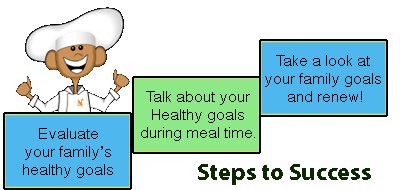
It’s that time of year when many people vow to have a better year than the last by setting New Years resolutions. The most common New Years resolutions often include weight loss, exercising more, and having an overall healthier diet. If you and your family are interested in gaining health in the New Year, read below for 10 ideas for New Years resolutions for a healthier family!
1) Cook together. The family that cooks together eats healthier together! Fast food and takeout can be go-to’s for busy families, but these foods are often unhealthy, high in sodium and saturated fat, and low in overall nutrition. If your family is always on the go during weeknights, spend an hour or two on Sundays cooking meals together that you can freeze and eat during the week! Examples include cooking chicken, brown rice, whole-wheat pasta, and homemade veggie pizza. You can also use this as an opportunity to teach your kids about food safety and nutrition!
2) Eat together. Not only is it important to cook together, it’s also important to eat together. If different members of the family are busy with different activities, it’s important to look at everyone’s schedule and find at least one day a week where you can all sit down to dinner together. Studies actually show that when families eat dinner together more often, their children achieve higher grades in school! Eating together also provides an opportunity for bonding and an appreciation of food. Be sure to also turn off the TV and put down the smartphones and tablets!
3) Brown bag it. Like getting fast food or takeout, giving the kids a few bucks for school lunch and buying your own lunch at work can be great when you’re short on time. However, like fast food or takeout, cafeteria food can also be high in sodium and saturated fat, and low in nutrients. Take a few minutes every weeknight or morning to make a healthy lunch with a grain, protein, fruit or vegetable, and dairy! This is also a good opportunity to teach the kids how to make a healthy lunch for themselves as well.
 4) Skip the saltshaker. While sodium is an important mineral that our bodies literally need to survive, in this day and age it’s easy to get more than we need, which can contribute to high blood pressure and other heart problems. The average person only needs about 2500 milligrams per day, which equals about a teaspoon! If you’re a regular user of the saltshaker and are looking for other flavor options, try herbs and spices such as garlic powder, onion, chili powder, parsley, or any other sodium-free spice blend. You can also spice up your food with flavorful vegetables such as sautéed garlic or onion!
4) Skip the saltshaker. While sodium is an important mineral that our bodies literally need to survive, in this day and age it’s easy to get more than we need, which can contribute to high blood pressure and other heart problems. The average person only needs about 2500 milligrams per day, which equals about a teaspoon! If you’re a regular user of the saltshaker and are looking for other flavor options, try herbs and spices such as garlic powder, onion, chili powder, parsley, or any other sodium-free spice blend. You can also spice up your food with flavorful vegetables such as sautéed garlic or onion!
5) Mind the mindless munching. Weight gain occurs when the amount of calories you eat is greater than the amount of calories you burn. An easy way for this to happen is to not be paying attention to your hunger and fullness signals, and eating when you’re bored or distracted. This can lead to mindlessly eating one handful of chips after another, and before you know it the bag is gone! Some ways to prevent mindless eating include pre-portioning out a snack by putting it in a bowl or plate, and being mindful while eating, which means paying attention to your food and being aware of the taste, texture, and flavors. Mindful eating helps you to keep awareness of your food so you’re not distracted and can feel satisfied. You can also teach your kids about mindful eating by having them mindfully eat a raisin and observing its appearance, taste, texture, and flavor.
6) Strive for 5. A well-balanced diet is made up of a variety of foods including protein, grains, dairy, and fruits and vegetables. While fruits and vegetables are some of the most nutritious foods on the planet, it’s easy to skimp on servings because of cost, preparation time, and flavor. Aiming for 5 fruits and vegetables is a good goal for a healthy diet, and this can include fresh, frozen, or canned fruits or vegetables. Frozen vegetables are often inexpensive and easy to prepare, and depending on where you live, there can be quite a variety of seasonal fresh fruits that are cheaper than out of season fruit. Make it a fun, family game to aim for 5 fruits and vegetables by providing stickers to everyone who achieves this goal every day!
7) Make time for breakfast. You may have heard from your own parents that breakfast is the most important meal of the day, and to this day this holds to be true! Your body spends the night fasting and when you wake up, you are running on very little fuel. Breakfast provides your body with the energy it needs to start the day, and studies show kids who eat breakfast daily get better grades in school! Eating breakfast can also help stop overeating or snacking later. Many families are extremely busy in the morning, so if this is the case, make breakfast to go! Examples include peanut butter on toast, an English muffin or waffles, a granola bar and a banana, yogurt with granola to eat at work, trail mix and an apple, or even cereal in a sandwich bag.
8) Substitute out soda. This year, aim to reduce or even mostly cutout soda, and swap it for healthier beverages such as water, juice, or milk. Soda is made of carbonated water and sugar, and lacks any real nutrients including vitamins and minerals. Soda can also contribute to cavities, and contains caffeine, which can cause jitteriness in both adults and children. If it’s the sweetness and carbonation you crave, try mixing some 100% fruit juice in seltzer water.
9) Make exercise part of family time. Between afterschool activities, soccer practice, and violin lessons, many families are busy catering to their children’s needs, and exercise is often put on the back burner. Exercise is an important part of a healthy lifestyle, and just 30 minutes a day can reduce your risk of many chronic diseases such as heart disease. Make exercise part of family time by engaging in whatever sport your child plays! Kick around the soccer ball, play catch, or shoot hoops. If no one is engaged in sports, try just taking a nice walk after dinner if you live in a safe area.
10) Catch some zzz’s. While diet and exercise are both big parts of a healthy lifestyle, it’s easy to overlook one last thing; sleep! According to the National Heart, Lung, and Blood Institute, sleep is important for mental health, physical health, quality of life, and safety. Getting enough sleep also makes it easier for you to be productive at work, and your children to pay attention in school. Parent should aim for 7-8 hours of sleep per night, while kids should aim for 10 to even 15, depending on their age. With busy family schedules, it can be difficult to get to bed on time, but try making it a priority for the sake of your mental and physical health. Set bedtimes for the whole family and turn off the TV 30 minutes before bed for a better quality of sleep.

0 Comments